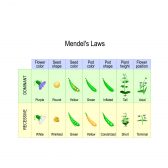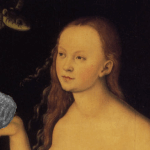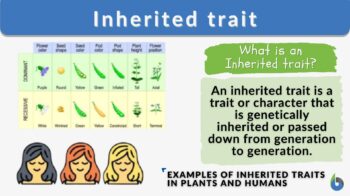
Inherited trait
n., plural: inherited traits
[ɪnˈhɛɹɪtɪd tɹeɪt]
Definition: Any trait or characteristic transferred from parents to the offspring
Table of Contents
What are Inherited Traits?
The characteristics or traits that are passed from parents to offspring are known as inherited traits. Traits are the defining qualities of an individual. Inherited traits are genetically transferred from the parents to the next generation. Some of the inherited traits include physical traits like, eye color, height, hair color and texture, freckles, blood group, certain diseases, etc. (Figure 1)
Every individual possesses certain unique traits that are a function of their genes and hence, such unique traits are transferred from one generation to the next generation.
However, siblings may possess few same traits like, physical characteristics namely height, skin color, etc. and siblings may have slightly different traits as well. This biological inheritance is also known as Heredity or inheritance and the study of heredity is known as genetics in biology.
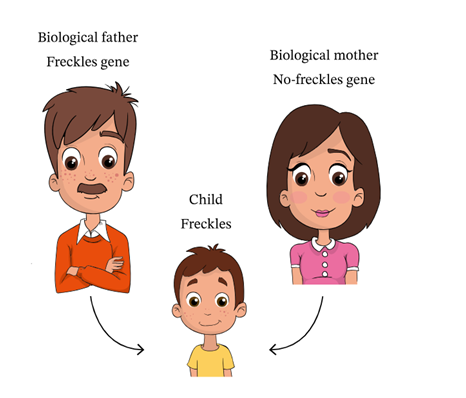
Heredity And Evolution
Heredity is defined as biological inheritance or inheritance. The inherited traits are transferred from parents to their offspring and these traits are encoded in the genes that are transferred from the parent cell to the progeny cell. Genes are part of Deoxyribonucleic acid (DNA) which are basically a specific sequential set of nucleotides in the DNA.
Let us now understand the basic life science process of how inherited traits are transferred.
Genes are DNA segment that forms the basic functional unit of heredity. DNA is a double-stranded polynucleotide chain that coils around to form a double helical structure. The sequence of nucleotides in the DNA contains all the genetic information of a living cell required for its normal functioning, growth, and reproduction.
Each nucleotide is constituted by a deoxyribose sugar and phosphate group along with four nucleic acid bases namely, cytosine [C], guanine [G], adenine [A], or thymine [T]. All the nucleic acid bases are joined with the help of covalent bonds or phosphodiester bonds.
The fundamental characteristic of living beings is their ability to reproduce. All living organisms acquire or inherit the necessary information for reproduction from their parents. To do so, all the living preexisting cells replicate their genetic material and then transferred it to the progeny cells.
The two strands of DNA store similar genetic information and hence during cell division when DNA strands separate, both DNA strands carry similar genetic information. Accordingly, for a trait, in sexual reproduction, duplicate genes are present. Each parent cell transfers one copy of the genetic material to the offspring cell. Thus the offspring cell has one copy each from the two parent cells.
However, in the case when the two sets of traits, transferred to the progeny, are not similar then the trait which is expressed is known as the dominant trait while the trait which is not expressed is referred to as the recessive trait. This variation in transmission and its expression traits leads to either survival benefits or genetic drift in a species. This forms the basis of variation within the same species and eventually evolution. However, few traits remain stable and constant within a species like, dogs have four legs, birds lay eggs, giraffes have long necks, etc.
All life forms evolved from common ancestors. Evolution is the progression of a higher form of living being from simple and lower forms of life. The selection of useful traits eventually leads to the formation of complex organs and organisms from simple organisms. Thus, evolution describes changes or alterations in inherited traits over a period of time. The changes in inherited traits and evolution are driven by the process of natural selection.
Watch this vid about traits, including inherited traits:
Biology definition:
Inherited traits are the traits or characteristics that are transferred from parents to the offspring, genetically. Some of the examples include eye color, skin color and texture, hair color and texture, height, and certain diseases like sickle cell anemia, Alzheimer’s disease, Tay Sachs, and diabetes.
Acquired Traits
Acquired traits are the characteristic feature of an individual which it has acquired through exposure to different environmental factors or external influences and interaction with different species. The acquired traits are not encoded in the genetic material of the individual and hence are not transferred from one generation to the next generation. Some examples of acquired traits include the ability to read, write, play musical instruments, and bodybuilding by regular exercising.
Inherited Traits Examples
Each human being has a certain unique characteristic trait that is often labeled as a ‘family trait or trait that runs in the family’. Some of the unique traits living beings acquire from their parents include…
- Hair color (Black/brown/blonde etc)
- Texture and type of hair (Rough/smooth or Straight/curly)
- Dimples
- Ability to roll tongue
- Use of left hand/right hand
- In females, menstruation onset and menopause
- Sleep pattern
- Color blindness
- The shape of the nose
- Skin color and texture
- Blood group
- Freckles
Certain genetic disorders are also inheritable, which include…
- Duchenne muscular dystrophy
- Alzheimer’s disease
- Dementia
- Cancer
- Diabetes
- Multiple sclerosis
- Heart diseases
- Alzheimer’s disease
- Arthritis
- Sickle cell anemia
- Tay-Sachs
- Cystic Fibrosis
- Huntington disease
- Hemochromatosis
- Congenital Deafness (non-syndromic)
- Familial hypercholesterolemia
- Cleft lip and palate
Did you know …?
Mitochondrial DNA is the only DNA that is exclusively transferred from the mother cell to the offspring, i.e., maternal inheritance. Type II Diabetes and multiple sclerosis are suspected to be having link with mitochondrial DNA. Leigh syndrome, lactic acidosis, and mitochondrial encephalopathy are some of the known mitochondrial inherited diseases.
Inherited traits in plants include (see Figure 2):
- Stem height
- Flower position
- Pod color and its shape
- Seed color and shape
- Flower color and shape
- Leaf pattern

Inherited traits in animals include: (see Figure 3)
- Body shape and size
- Eye color and shape
- Fur color or coat color and patterns like, spotted/stripped
- Tail shape and length
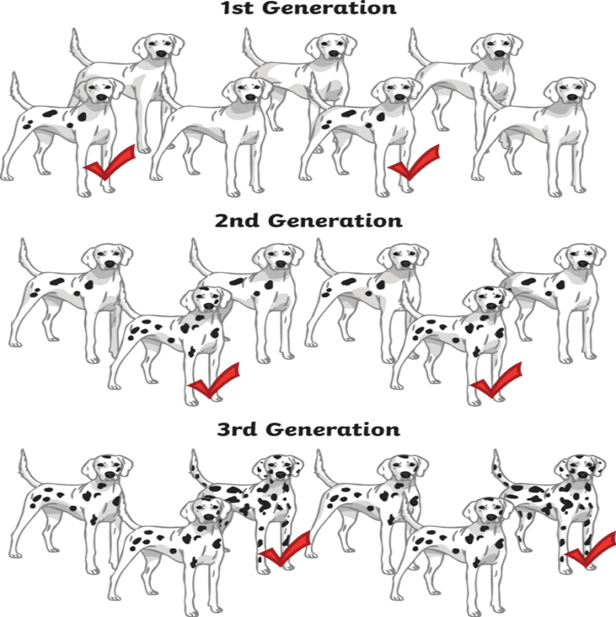
Rules For The Inheritance Of Traits – Mendel’S Contributions
Gregor Mendel is known as the ‘Father of Genetics’ and he studied the inheritance of traits by carrying out experiments on pea plants (Pisum sativum). Based on the results and observation of the experiments on pea plants, Mendel gave the ‘Laws of Inheritance’ (or Mendel’s law of inheritance).
Pea plants were selected because:
- Ease of growing pea plants and their low maintenance
- Availability of pea plants with distinct and opposing characteristics
- Annual plants and hence multiple generations can be studied in a shorter duration
- Natural self-pollinator plants can also be easily cross-pollinated
Mendel enlisted and used certain distinct characteristics pea plant which are shown in Figure 4.
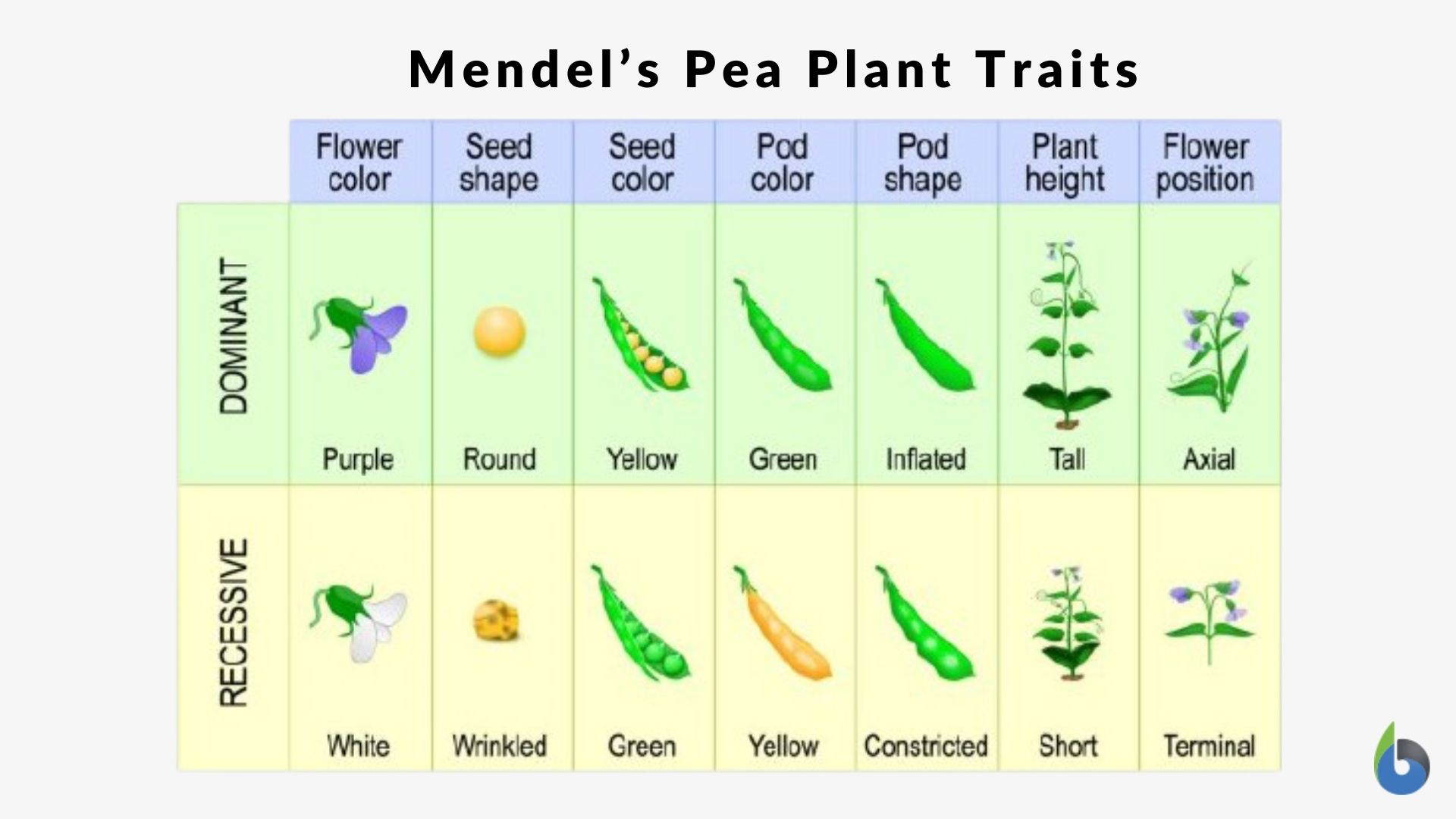
Mendel carried out experiments in two ways:
1. One pair of contrasting characteristics in pure breed line (e.g.: Green pod plant Vs yellow pod plant) – Monohybrid cross (Figure 5)
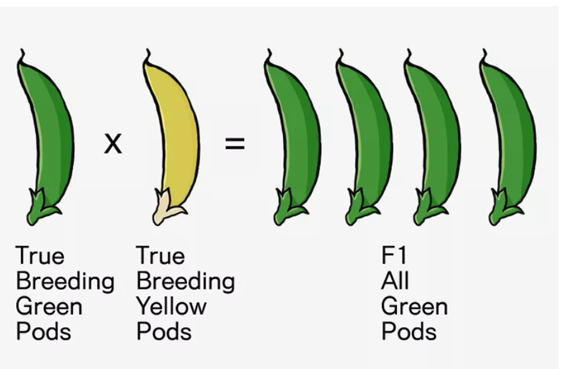
2. Two traits with two alleles (for e.g: green-wrinkled seeds Vs yellow-round seeds) – Dihybrid cross (Figure 6).
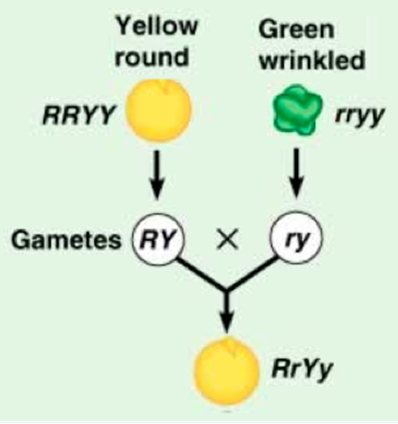
The parent plants having contrasting characteristics were cross-pollinated and the resultant progeny was named as F1 generation (first filial generation). The F1 generation was then self-pollinated and the resultant generation was named as F2 Generation.
Some major observations made in pea experiments include:
- In a monohybrid cross, pea plants having green pod and yellow pod characteristics were crossed and in the resultant F1 generation, all the plants were green. (Figure 5).
- In the F2 generation of the monohybrid cross, out of four, three plants were green pods and one was a yellow pod. (Figure 6)
- A similar pattern was observed for the other traits/characteristics
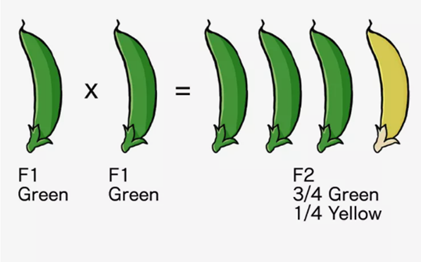
These findings led to the following conclusions
- In the F1 generation, traits of only one of the parents are seen while in the F2 generation traits of another parent also appear
- The traits visible in the F1 generation are known as Dominant traits while the trait that appears in the F2 generation is known as Recessive trait.
- Genotype is the genetic constitution while the physical appearance of the trait is known as phenotype.
- Parents transfer genes in pairs to the offspring, known as alleles.
- In gametogenesis, there is a 50% probability that one of the alleles from one parent combines with one of the alleles from the other parent.
- When the two same kinds of alleles are present, it is known as homozygous alleles while the genotype of different alleles is referred to as heterozygous alleles.
Based on these observations and conclusion, Mendel laid upon three laws of inheritance:
- Law of Dominance: This law is also known as the First law of inheritance, according to which, when parents having two contrasting traits are crossed over, the resultant progeny will express the trait of one parent only which is a Dominant trait while the other trait which is not expressed is known as Recessive trait. Of the two alleles in the offspring, the dominant trait will express while the Recessive trait remains unexpressed in the progeny.
- Law of Segregation: This law is known as the Second law of inheritance, according to which, each trait has a pair of alleles. These allele genes segregate and one of the allele genes is transferred to the offspring. Hence, each offspring acquires one set of allele genes from each parent.
- Law of Independent Assortment: This law is known as the Third law of inheritance, according to which, the transfer of allele from parents to offspring occurs independently of each other thus, providing equal opportunity for the alleles to transfer from parents to offspring.
How Do Traits Get Expressed?
DNA present in the cell is the information center for all life processes. DNA has all the genetic information in the genetic code. Each DNA contains a section, known as a gene, that encodes the information for a protein. The traits are controlled by genes. According to Mendel law of Inheritance, each parent contributes equally to the offspring cell and thus the offspring inherits genes from both parents. Each cell contains 2 sets of chromosomes (which contains all the genes) wherein, one chromosome is acquired from the father germ cell and the other from the mother cell. Of these traits or genes, dominant genes are expressed while recessive gene or traits remain unexpressed.
Sex Determination
In humans, the sex of the offspring is determined by the genetic constitution of the offspring. Humans contain 23 pairs of chromosomes, except for the sex chromosome. Female offspring has a ‘XX’ set of chromosomes while male offspring has ‘XY’ chromosomes. The y chromosome is shorter than the X chromosome. According to this, all offspring will inherit X chromosomes from the mother, however, from the father, the offspring will either inherit the ‘X’ or ‘Y’ chromosome, which will eventually determine the sex of the offspring. Thus, it is the male germ cell that will determine the sex of the child.
In contrast, in reptiles and other organisms, the sex of the offspring is determined by the environmental conditions (like, temperature) during the fertilization of the egg.
Take the Inherited Traits – Biology Quiz!
References
- Florez, J. C., Hirschhorn, J., & Altshuler, D. (2003). The inherited basis of diabetes mellitus: implications for the genetic analysis of complex traits. Annual review of genomics and human genetics, 4(1), 257-291.
- · Hopwood, C. J., Donnellan, M. B., Blonigen, D. M., Krueger, R. F., McGue, M., Iacono, W. G., & Burt, S. A. (2011). Genetic and environmental influences on personality trait stability and growth during the transition to adulthood: a three-wave longitudinal study. Journal of personality and social psychology, 100(3), 545–556. https://doi.org/10.1037/a0022409
- · Sanchez-Roige, S., Gray, J. C., MacKillop, J., Chen, C. H., & Palmer, A. A. (2018). The genetics of human personality. Genes, brain, and behavior, 17(3), e12439. https://doi.org/10.1111/gbb.12439
- · Schärli, N., Ducasse, S., Nierstrasz, O., & Black, A. P. (2003). Traits: Composable units of behaviour. In ECOOP 2003–Object-Oriented Programming: 17th European Conference, Darmstadt, Germany, July 21-25, 2003. Proceedings 17 (pp. 248-274). Springer Berlin Heidelberg.
©BiologyOnline.com. Content provided and moderated by Biology Online Editors.

